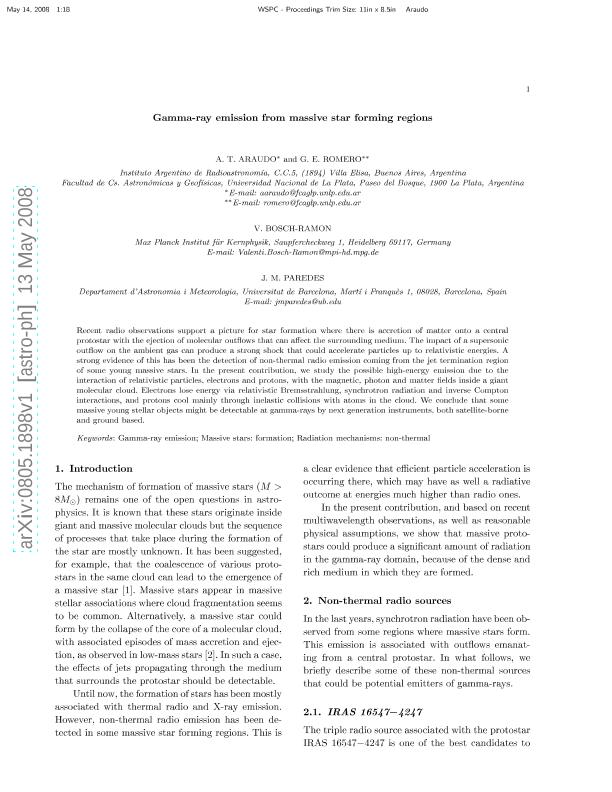Mostrar el registro sencillo del ítem
dc.contributor.author
Araudo, Anabella Teresa

dc.contributor.author
Romero, Gustavo Esteban

dc.contributor.author
Bosch Ramon, Valentí

dc.contributor.author
Paredes, Josep Maria

dc.date.available
2017-11-08T14:41:26Z
dc.date.issued
2008-09
dc.identifier.citation
Araudo, Anabella Teresa; Romero, Gustavo Esteban; Bosch Ramon, Valentí; Paredes, Josep Maria; Gamma-ray emission from massive star forming regions
; World Scientific; International Journal of Modern Physics D; 17; 10; 9-2008; 1889-1894
dc.identifier.issn
0218-2718
dc.identifier.uri
http://hdl.handle.net/11336/27816
dc.description.abstract
Recent radio observations support a picture for star formation where there is accretion of matter onto a central protostar with the ejection of molecular outflows that can affect the surrounding medium. The impact of a supersonic outflow on the ambient gas can produce a strong shock that could accelerate particles up to relativistic energies. A strong evidence of this has been the detection of non-thermal radio emission coming from the jet termination region of some young massive stars. In the present contribution, we study the possible high-energy emission due to the interaction of relativistic particles, electrons and protons, with the magnetic, photon and matter fields inside a giant molecular cloud. Electrons lose energy via relativistic Bremsstrahlung, synchrotron radiation and inverse Compton interactions, and protons cool mainly through inelastic collisions with atoms in the cloud. We conclude that some massive young stellar objects might be detectable at gamma-rays by next generation instruments, both satellite-borne and ground based.
dc.format
application/pdf
dc.language.iso
eng
dc.publisher
World Scientific

dc.rights
info:eu-repo/semantics/openAccess
dc.rights.uri
https://creativecommons.org/licenses/by-nc-sa/2.5/ar/
dc.subject
Gamma-Ray Emission
dc.subject
Massive Stars
dc.subject
Nonthermal Radiation Mechanisms
dc.subject.classification
Astronomía

dc.subject.classification
Ciencias Físicas

dc.subject.classification
CIENCIAS NATURALES Y EXACTAS

dc.title
Gamma-ray emission from massive star forming regions
dc.type
info:eu-repo/semantics/article
dc.type
info:ar-repo/semantics/artículo
dc.type
info:eu-repo/semantics/publishedVersion
dc.date.updated
2017-10-12T19:39:16Z
dc.identifier.eissn
1793-6594
dc.journal.volume
17
dc.journal.number
10
dc.journal.pagination
1889-1894
dc.journal.pais
Singapur

dc.description.fil
Fil: Araudo, Anabella Teresa. Provincia de Buenos Aires. Gobernación. Comisión de Investigaciones Científicas. Instituto Argentino de Radioastronomía. Consejo Nacional de Investigaciones Científicas y Técnicas. Centro Científico Tecnológico Conicet - La Plata. Instituto Argentino de Radioastronomía; Argentina
dc.description.fil
Fil: Romero, Gustavo Esteban. Provincia de Buenos Aires. Gobernación. Comisión de Investigaciones Científicas. Instituto Argentino de Radioastronomía. Consejo Nacional de Investigaciones Científicas y Técnicas. Centro Científico Tecnológico Conicet - La Plata. Instituto Argentino de Radioastronomía; Argentina
dc.description.fil
Fil: Bosch Ramon, Valentí. Max Planck Institut für Kernphysik; Alemania
dc.description.fil
Fil: Paredes, Josep Maria. Universidad de Barcelona; España
dc.journal.title
International Journal of Modern Physics D

dc.relation.alternativeid
info:eu-repo/semantics/altIdentifier/doi/http://dx.doi.org/10.1142/S0218271808013534
dc.relation.alternativeid
info:eu-repo/semantics/altIdentifier/url/http://www.worldscientific.com/doi/abs/10.1142/S0218271808013534
Archivos asociados
